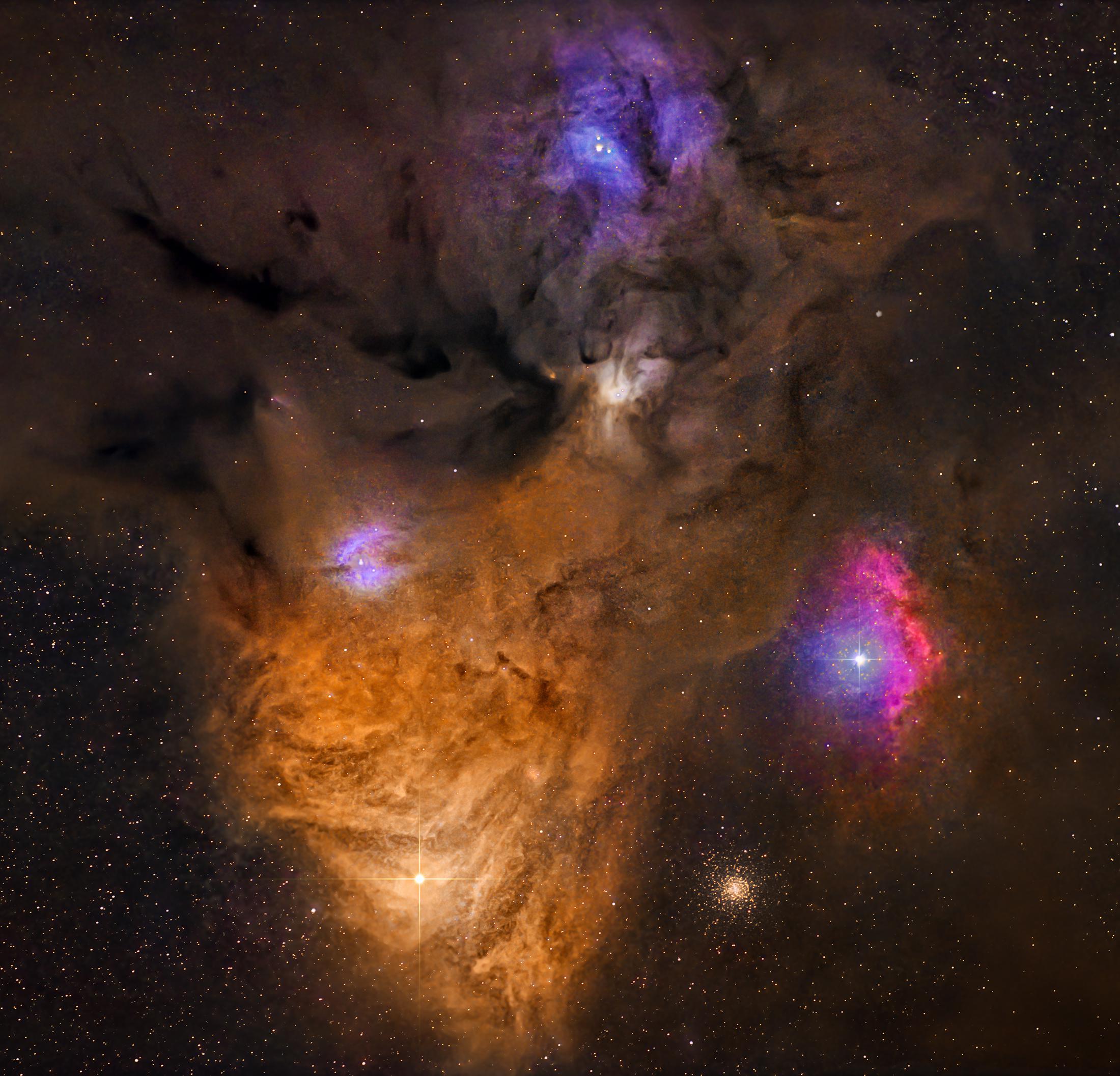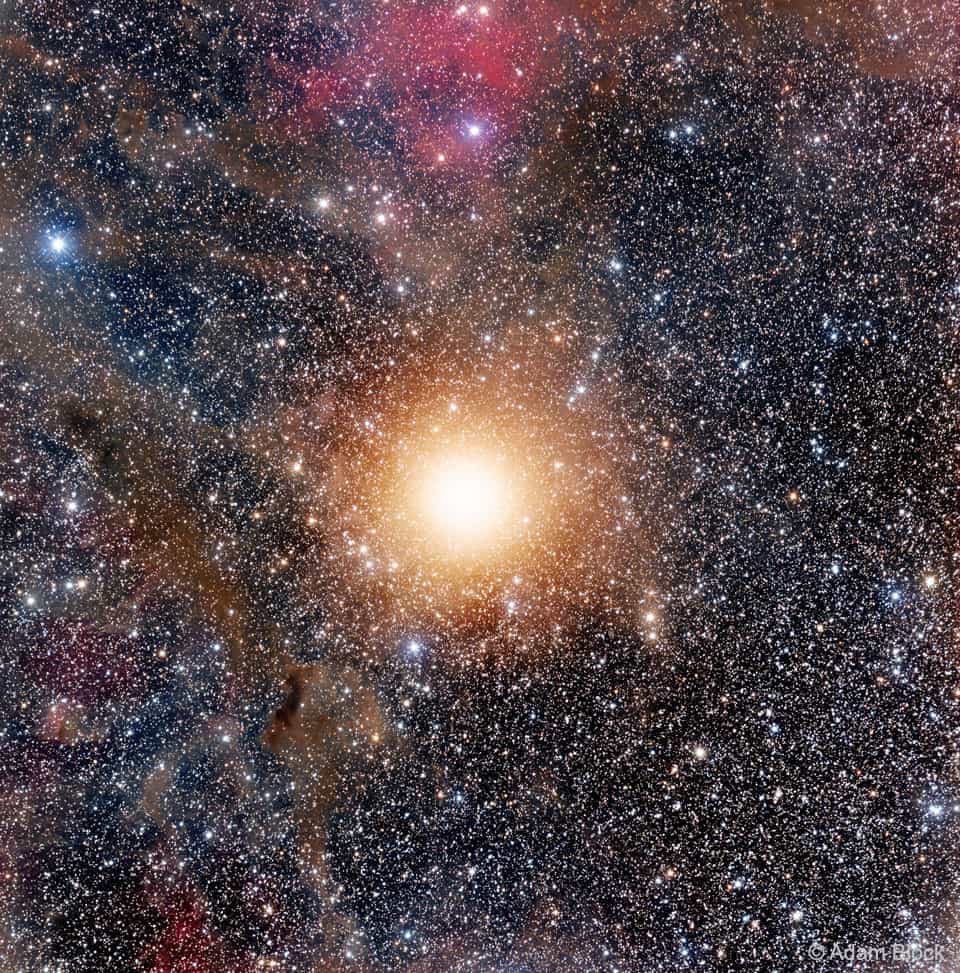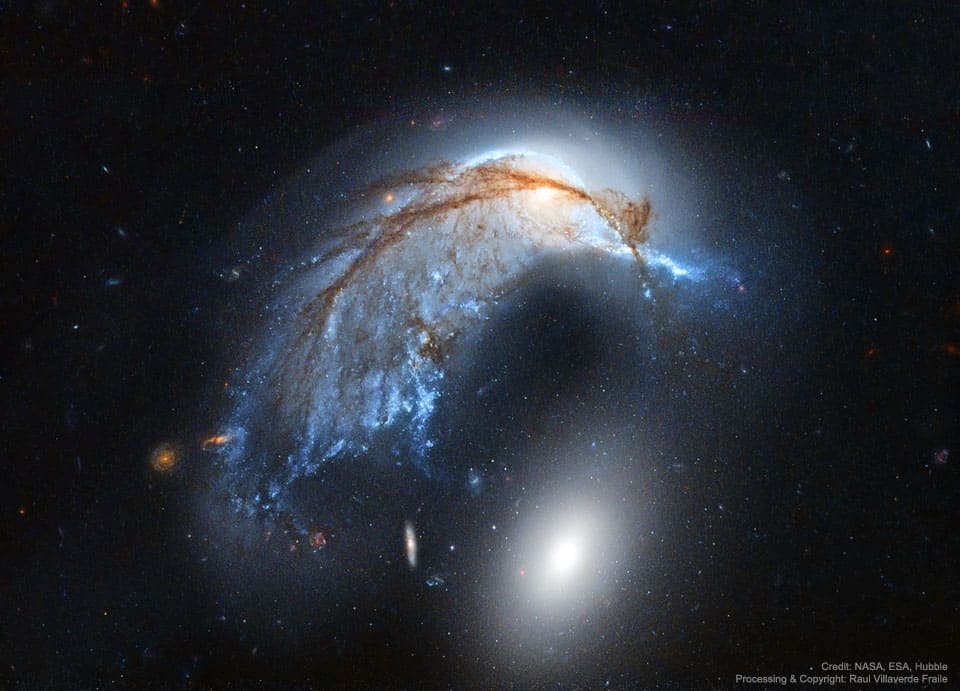Blog
Rho Ophiuchi (ρ Ophiuchi) is a multiple star system in the constellation Ophiuchus. The central system has an apparent magnitude of 4.63. Based on the central system’s parallax of 9.03 mas,it is located about 360 light-years (110 parsecs) away. The other stars in the system are slightly farther away.
Rho Ophiuchi is the namesake of the Rho Ophiuchi cloud complex. It is a nebula of gas and dust, which the Rho Ophiuchi system is embedded in. It is one of the easiest star forming regions to observe, as it is one of the nearest, and it is visible from both hemispheres.
The interstellar extinction (AV) of Rho Ophiuchi is measured to be 1.45 magnitudes, meaning the dust and gas in front of Rho Ophiuchi absorbs light from the system, making it appear 1.45 magnitudes dimmer than it should be. Additionally, gas and dust also scatters more higher-frequency light, leaving the light appearing more reddish. The interstellar reddening (EB−V) of Rho Ophiuchi has been measured to be 0.47 magnitudes.

Stephen Lawrence Winwood (born 12 May 1948) is an English singer, songwriter and musician whose genres include progressive rock, blue-eyed soul, rhythm and blues, blues rock, pop rock, and jazz. Though primarily a vocalist and keyboard player, Winwood also plays a wide variety of other instruments; on several of his solo albums he has played all instrumentation, including drums, mandolin, guitars, bass and saxophone.
Winwood was a key member of The Spencer Davis Group, Traffic, Blind Faith and Go. He also had a successful solo career with hits including “While You See a Chance“, “Valerie“, “Back in the High Life Again” and two US Billboard Hot 100 number ones, “Higher Love” and “Roll with It” charting 20 years after the start of his recording career. He was inducted into the Rock and Roll Hall of Fame as a member of Traffic in 2004.
In 2005 Winwood was honoured as a BMI Icon at the annual BMI London Awards for his “enduring influence on generations of music makers”. In 2008, Rolling Stone ranked Winwood No. 33 in its 100 Greatest Singers of All Time. Winwood has won two Grammy Awards. He was nominated twice for a Brit Award for Best British Male Artist: 1988 and 1989. In 2011 he received the Ivor Novello Award from the British Academy of Songwriters, Composers and Authors for Outstanding Song Collection.
more...Gary Peacock is a seminal part of jazz history. Born May 12th 1935 in Burley, Idaho, he grew up in Yakima, Washington, studied piano at the Westlake College of Music in Los Angeles and played piano in the army until the group’s bassist quit and Peacock took over the chair.
Back in the US, Peacock worked on the West Coast with Bud Shank, Art Pepper, Barney Kessel, Paul Bley and Ornette Coleman and on the East Coast with Miles Davis, Bill Evans, Jimmy Giuffre, Albert Ayler, Paul Motian, Roland Kirk and Don Cherry. In 1964 Peacock left the music scene to study Eastern medicine in Japan, then came back to America to study biology. Gradually he started playing again and in the early ’80s he started working with Keith Jarrett and Jack DeJohnette, a collaboration that continues to this day.
Peacock makes his home in upstate New York, where among other activities he helps run a meditation group in a prison.
more...Gerald Foster Wiggins, Sr. (May 12, 1922 – July 13, 2008) was a jazz pianist and organist.Wiggins was born in New York City on May 12, 1922. He studied classical music, but switched to jazz in his teens.
Wiggins began as a professional playing accompaniment to comedian Stepin Fetchit. Wiggins worked with Louis Armstrong and Benny Carter. He was in the military from 1944 to 1946. In the 1940s he moved to Los Angeles, where he played music for television and film. He also worked with singers like Lena Horne (1950–51), Kay Starr, and Eartha Kitt. In 1960 his best recording as an organist appeared, Wiggin’ Out, known for the quality of its music and fresh, clear sound. He recorded another LP at the organ with saxophonist Teddy Edwards. “In the 1960s he worked as a music director and vocal coach in film studios,”including “a lengthy stint as vocal coach for Marilyn Monroe.
more...One of the brighter and more unusual stars in the sky, the red supergiant star Betelgeuse can be found in the direction of famous constellation Orion. Betelgeuse, however, is actually well in front of many of the constellation’s other bright stars, and also in front of the greater Orion Molecular Cloud Complex. Numerically, light takes about 700 years to reach us from Betelgeuse, but about 1,300 years to reach us from the Orion Nebula and its surrounding dust and gas. All but the largest telescopes see Betelgeuse as only a point of light, but a point so bright that the inherent blurriness created by the telescope and Earth’s atmosphere make it seem extended. In the featured long-exposure image, thousands of stars in our Milky Way Galaxy can be seen in the background behind Betelgeuse, as well as dark dust from the Orion Molecular Cloud, and some red-glowing emission from hydrogen gas on the outskirts of the more distant Lambda Orionis Ring. Betelgeuse has recovered from appearing unusually dim over the past six months, but is still expected to explode in a spectacular supernova sometime in the next (about) 100,000 years.

May-11-1976
Greek oudist, pianist and composer Alekos Vretos has been merging jazz, Arabic, Greek and Latin music in a masterful blend of sounds from traditional instruments, such as the oud or the nay, vs. the modern ones. As a bandleader, Alekos has developed a unique atmosphere for his music: keeping traditional sound in the front line, he expands it through jazz improvisation and exploding rhythmic development.
In 2014, Alekos released his 2nd personal CD K. on Top. A long way musically from his previous work Mergin K. on Top is a statement of how World music and Jazz should be mixed without becoming to separate genres in one piece. Mature and stable, he is walking the line of good and tasteful musicianship overall. For his work and help towards the music scene (especially World Jazz), he was included in 2013 list of the 100+1 most influential people in the Greek music scene published by the Athens Voice newspaper.
more...Eric Victor Burdon (born 11 May 1941) is an English singer-songwriter and actor. He was previously the vocalist of rock band The Animals and funk band War. He is regarded as one of the British Invasion‘s most distinctive singers with his deep, powerful blues-rock voice. He is also known for his aggressive stage performances.
In 2008, he was ranked 57th in Rolling Stone‘s list The 100 Greatest Singers of All Time.
Eric Burdon was born in 1941 in Walker, Newcastle upon Tyne, England. His father, Matt, was originally from Tyneside. His mother, Rene, was originally from Ireland and moved to Scotland before settling in Newcastle in the 1930s. He also had a younger sister, Irene. Burdon later recalled that his middle name “Victor” had been chosen after encouragement from the Lord Mayor, who offered new mothers £25 if their new-borns were given a patriotic “war name”.
more...Carla Bley (born Lovella May Borg, May 11, 1938) is an American jazz composer, pianist, organist and bandleader. An important figure in the free jazz movement of the 1960s, she is perhaps best known for her jazz opera Escalator over the Hill (released as a triple LP set), as well as a book of compositions that have been performed by many other artists, including Gary Burton, Jimmy Giuffre, George Russell, Art Farmer, John Scofield and her ex-husband Paul Bley.
Bley was born in Oakland, California, United States, to Emil Borg (1899–1990), a piano teacher and church choirmaster, who encouraged her to sing and to learn to play the piano, and Arline Anderson (1907–1944), who died when Bley was eight years old. After giving up the church to immerse herself in roller skating at the age of fourteen, she moved to New York at seventeen and became a cigarette girl at Birdland, where she met jazz pianist Paul Bley. She toured with him under the name Karen Borg, before she changed her name in 1957 to Carla Borg and married Paul Bley the same year adopting the Bley name. He encouraged her to start composing. The couple later divorced but she kept his surname professionally.
A number of musicians began to record Bley’s compositions: George Russell recorded “Bent Eagle” on his 1960 release Stratusphunk in 1960; Jimmy Giuffre recorded “Ictus” on his album Thesis; and Paul Bley’s Barrage consisted entirely of her compositions. Throughout her career Bley has thought of herself as a writer first, describing herself as 99 percent composer and one percent pianist.
In 1964 she was involved in organising the Jazz Composers Guild, which brought together the most innovative musicians in New York at the time. She then had a personal and professional relationship with Michael Mantler, with whom she had a daughter, Karen, now also a musician in her own right. Bley and Mantler were married from 1965-91. With Mantler, she co-led the Jazz Composers’ Orchestra and started the JCOA record label which issued a number of historic recordings by Clifford Thornton, Don Cherry and Roswell Rudd, as well as her own magnum opus Escalator Over The Hilland Mantler’s The Jazz Composer’s Orchestra LPs. Bley and Mantler were pioneers in the development of independent artist-owned record labels and also started the now defunct New Music Distribution Service which specialized in small, independent labels that issued recordings of “creative improvised music”.
She arranged and composed music for bassist Charlie Haden‘s Liberation Music Orchestra, and wrote A Genuine Tong Funeral for vibraphonist Gary Burton. Bley has collaborated with a number of other artists, including Jack Bruce, Robert Wyatt and Nick Mason, drummer for the rock group Pink Floyd. Mason’s solo debut album Nick Mason’s Fictitious Sports was entirely written by Bley and performed by her regular band with Mason as a guest, making it in effect a Carla Bley album in all but name.
more...Frederick Roach (May 11, 1931 – October 3, 1980) was an American soul jazz Hammond B3 organist born in The Bronx, New York, United States. He was one of a handful of legendary jazz organists that made history in the 1960s, the golden era of the Hammond organ. Roach made his record debut in 1960 with saxophonist Ike Quebec on the albums Heavy Soul and It Might as Well Be Spring and played with Willis Jackson. From 1962-64 he recorded 5 albums as a leader for the Blue Note Records label and also recorded with Donald Byrd on the album I’m Tryin’ to Get Home. Roach’s original writing, steady basslines, and highly musical fleet-fingered right hand set him apart. From 1966-67 he recorded three more albums as a leader for Prestige Records, which are in a more commercial vein than his Blue Note dates. He left the music business in 1970 and became involved in theater, playwriting and film. Reportedly, he moved to California to the film industry, where he suffered a heart attack and died in 1980.
Roach was a soulful organist, certainly influenced by Jimmy Smith, but with a distinct sound and a quite original concept, which was perhaps best heard on “Good Move” for Blue Note. His Blue Note albums are critically acclaimed.
https://www.youtube.com/watch?v=gZVBn8UJm0c
more...Just a few hundred million years ago, NGC 2936, the upper of the two large galaxies shown, was likely a normal spiral galaxy — spinning, creating stars — and minding its own business. But then it got too close to the massive elliptical galaxy NGC 2937 below and took a dive. Dubbed the Porpoise Galaxy for its iconic shape, NGC 2936 is not only being deflected but also being distorted by the close gravitational interaction. A burst of young blue stars forms the nose of the porpoise toward the right of the upper galaxy, while the center of the spiral appears as an eye. Alternatively, the galaxy pair, together known as Arp 142, look to some like a penguin protecting an egg. Either way, intricate dark dust lanes and bright blue star streams trail the troubled galaxy to the lower right. The featured re-processed image showing Arp 142 in unprecedented detail was taken by the Hubble Space Telescope last year. Arp 142 lies about 300 million light years away toward the constellation, coincidently, of the Water Snake (Hydra). In a billion years or so the two galaxies will likely merge into one larger galaxy.

More Posts
- Larry Willis Day
- Cousin Joe Day
- Flamenco Fridays with CAMARÓN
- Daily Roots with the Eclips Band
- The Cosmos with Abell 21
- Kermit Ruffins Day
- Lenny White Day
- Bobby Timmons Day
- Professor Longhair Day
- Edith Pilaf Day
- World Fusion with Tom Teasley
- Daily Roots with the Immortals
- The Cosmos with M81/82
- Keith Richards Day
- Wadada Leo Smith Day
- Harold Land Day
- Eddie “Cleanhead” Vinson Day
- World Music with Hamid el Kasri
- Daily Roots with the Viceroys
- The Cosmos with Barnard 33

